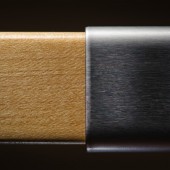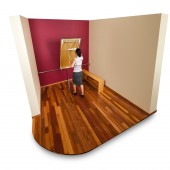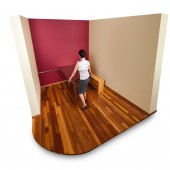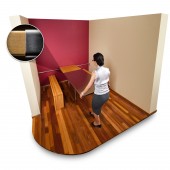
| THE AWARD |
| CATEGORIES |
| REGISTRATION |
| SUBMIT YOUR WORK |
| ENTRY INSTRUCTIONS |
| TERMS & CONDITIONS |
| PUBLICATIONS |
| DATES & FEES |
| METHODOLOGY |
| CONTACT |
| WINNERS |
| PRESS ROOM |
| GET INVOLVED |
| DESIGN PRIZE |
| DESIGN STORE |
| THE AWARD | JURY | CATEGORIES | REGISTRATION | PRESS | WINNERS | PUBLICATIONS | ENTRY INSTRUCTIONS |
Arry Table Multifunctional Table by Arry Yu |
Home > Winners > Design #25229 >Interview |
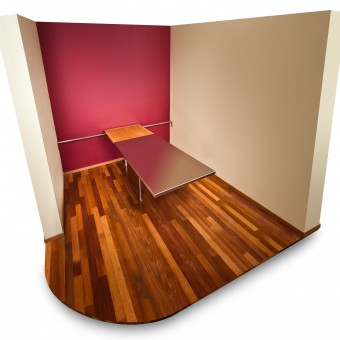 |
|
FS: What is the main principle, idea and inspiration behind your design?
AY: From 2006 to 2009, I spent three years looking and searching for this very specific vision of a table I had in mind for my small apartment, where I lived alone. I did not want to just buy any table - because that would lock me in as I would not be able to hide or move that table once in place. I had to find the perfect table. I could picture this dream perfect table – but I could not find it anywhere in the world. I needed a table that 1) gave me the flexibility I needed to get the maximum benefit out of the limited space I have, 2) was easy for me to handle by myself without the aid of others, and 3) looked modern and visually appealing.
FS: What has been your main focus in designing this work? Especially what did you want to achieve?
AY: Because I could not find this perfect table anywhere in the world, I decided to design and build it myself. The table had to: 1) give me the flexibility I needed to get the maximum benefit out of the limited space I have, 2) be easy for me to handle by myself without the aid of others, and 3) look modern and be visually appealing. I wanted it to be flexible enough so I could put the table "away" when I wanted an open room, put the table easily in any location in the room I wanted, be able to elongate it without the need of anything technically complicated or leaflets. I wanted this table to be flexible, simple, yet sophisticated visually. Since I lived alone, I did not want to have to call a neighbor or someone to come over to help me - I needed something light weight, yet very sturdy.
FS: What are your future plans for this award winning design?
AY: My future plans are to continue building and selling the Arry Table designs, including expanding my line of available designs and products. I would love to see this table in every small space apartment, condo, hotel, office, and restaurant around the world - particularly the patent pending continuously extendible surface design feature.
FS: How long did it take you to design this particular concept?
AY: Once I decided to build and design this table, it took me a few months to build the original design concept. I began the design process in August of 2009; I had a completed working prototype of the table by October 2009. The Arry Table has since, changed the way I live in my small apartment.
FS: Why did you design this particular concept? Was this design commissioned or did you decide to pursuit an inspiration?
AY: I designed it because I had a need, and because I did not want to settle for any table. I was looking for the perfect table.
FS: Is your design being produced or used by another company, or do you plan to sell or lease the production rights or do you intent to produce your work yourself?
AY: No, this table is not being produced or used by any other company. The Arry Table is a patent-pending design and I am the only one building these tables. I am open to opportunities to partner with other brands and companies.
FS: What made you design this particular type of work?
AY: I designed it because I had a need, and because I did not want to settle for any table. I was looking for the perfect table. I did not want to be stuck with any table in my small home - and so I designed and built that perfect table.
FS: Where there any other designs and/or designers that helped the influence the design of your work?
AY: I love mid-century modern designs, Frank Lloyd Wright, and designs by Herman Miller - so you can say those were influences in the design of my work. I love well constructed, simple and unique artistry - particularly socially conscious products that are green, environmentally safe, use recycled materials whenever possible, and are of quality materials. I've always been a big fan of mixed media - so the idea of using wood with metal felt right to me.
FS: Who is the target customer for his design?
AY: The target customer for this design is anyone who has limited space and wants far more flexibility than is currently available with the kinds of tables that are available today. For a restaurant, this means a table that normally seats 2 people can be made to seat 4 people with one very quick and easy movement. For an apartment or condominium, this means having a table that can be easily put away for ultimate open space, or a table that seats anywhere from a small group of 2-4 people to a large group of 6-10 people. In an office setting, this means one can have a table for a small group discussion that easily expands to be a full-sized conference table.
FS: What sets this design apart from other similar or resembling concepts?
AY: What sets this design apart from other tables is its patent-pending continuously extendible surface that allows you to literally extend the surface of the table by simply pulling out the sleeve. No leaflets are necessary. No complicated mechanical pieces are involved at all. The table can be extended, moved, and stored with one simple gliding motion by one person.
FS: How did you come up with the name for this design? What does it mean?
AY: The Arry Table was named through my community of family and friends who had seen my prototype table, who gave it the name, the "Arry Table". The table name then caught on as the community in Seattle, WA found out about it. The name "Arry" is my first name, pronounced, "air-ree" and means love in Korean.
FS: Which design tools did you use when you were working on this project?
AY: Because I am not a designer by education or trade, most of the design was built simply by using a pen and paper to communicate to a carpenter who helped me build my table prototype. I've continued to design and deliver new products in this fashion by having strong technicians that I work with to translate my design requirements.
FS: What is the most unique aspect of your design?
AY: 1) The continuously extendible surface which is the very thin stainless steel sleeve that envelopes the inner wood table surface. This sleeve that can easily pull out to extend the table and push in to retract the table length. 2) the second unique aspect is the stainless steel bar that allows any user of the table to move the table easily from side-to-side or put the table away by moving it against the wall.
FS: Who did you collaborate with for this design? Did you work with people with technical / specialized skills?
AY: Because I am not a designer by education or trade, most of the design was built simply by using a pen and paper to communicate to a carpenter who helped me build my table prototype. I've also used the input of architects and industrial designers to review my design requirements, and build shop drawings.
FS: What is the role of technology in this particular design?
AY: N/A
FS: Is your design influenced by data or analytical research in any way? What kind of research did you conduct for making this design?
AY: The design was not influenced by data in any way. I spent about 3 years looking for this perfect table, but was unable to find it. I also previously hired research assistants to help me look for this kind of table during that time, but with no success.
FS: What are some of the challenges you faced during the design/realization of your concept?
AY: Once the design concept had been created, several iterations of the product were created to address challenges around the table legs. The table legs had to be strong enough to hold the table horizontally up when both in closed and extended positions - but also light enough to use as a lifting device to put the table vertically away onto the wall. Often the table legs that were used in the earlier designs had difficulty folding on the wall, and then folding out smoothly when the table was brought down to the floor. We turned to a custom solution to answer this challenge.
FS: How did you decide to submit your design to an international design competition?
AY: I learned about the idea of entering design competitions through the advice of a woman who attended an open house I was hosting for my Arry Table, sponsored by Apartment Therapy. I took her advice and then decided I was interested in finding an international design community to submit my work to because I believe the Arry Table has much potential especially in Europe and Asia.
FS: What did you learn or how did you improve yourself during the designing of this work?
AY: I learned the art of iteration - and the art of moving forward. The art of moving forward allows a person to figure out very quickly and effectively if you are moving in the right direction. The art of iteration allows a person to figure out very quickly and effectively what to modify to improve the design. Without moving forward and without iteration, it is very difficult to continuously refine a product. I've learned that creativity, persistence and some bravery goes a long way in the world of product design.
FS: Any other things you would like to cover that have not been covered in these questions?
AY: Not at this time.
FS: Thank you for providing us with this opportunity to interview you.
A' Design Award and Competitions grants rights to press members and bloggers to use parts of this interview. This interview is provided as it is; DesignPRWire and A' Design Award and Competitions cannot be held responsible for the answers given by participating designers.
| SOCIAL |
| + Add to Likes / Favorites | Send to My Email | Comment | View Press-Release |

